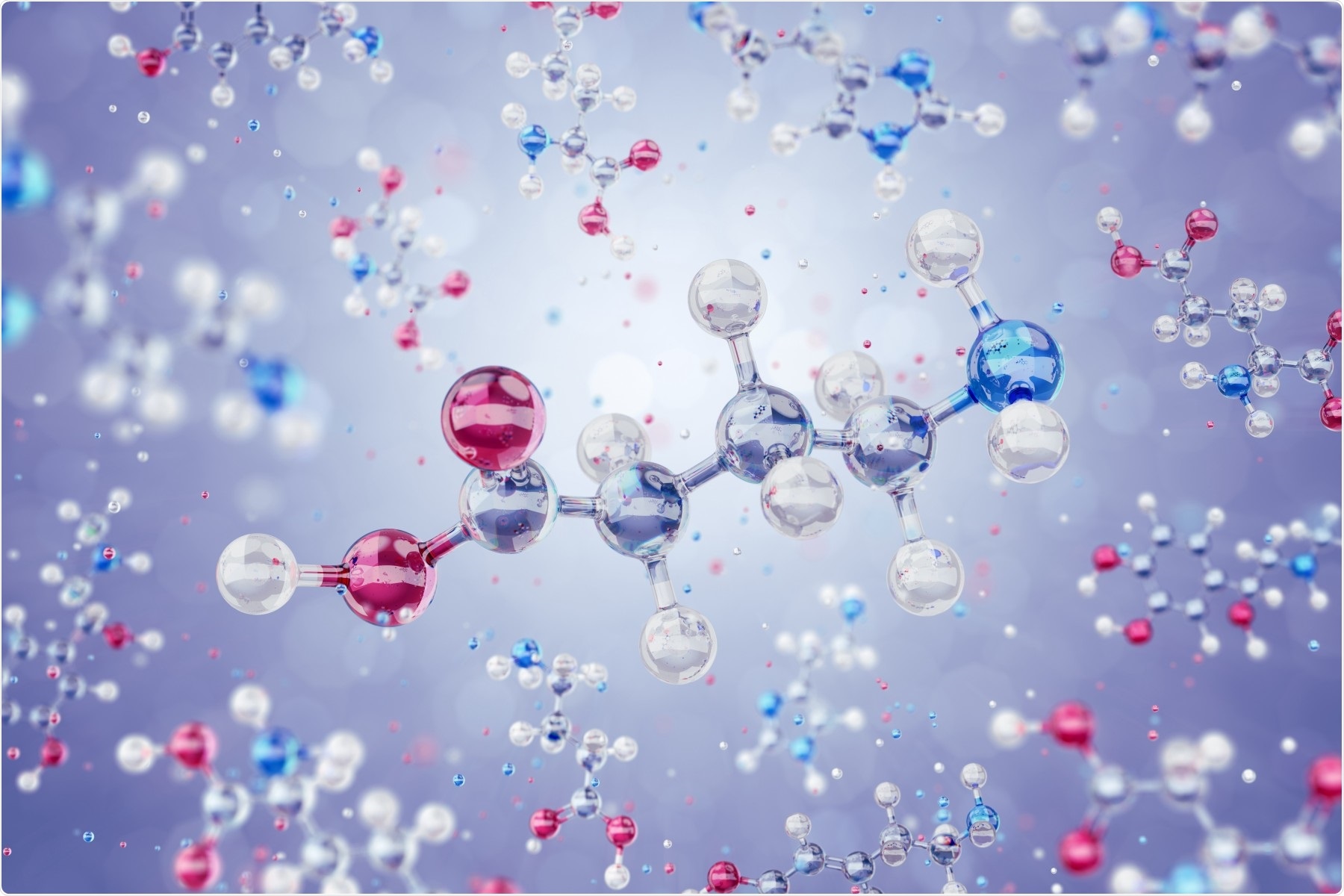Researchers have found that a human receptor protein can identify individual amino acids in just the similar way that bacteria do.

The study findings could lead to enhancements of drugs derived from the amino acid GABA, or gamma-aminobutyric acid, represented here in a 3D model. Image Credit: Artystarty | Getty Images
The result can lead to improvement of drugs derived from the amino acid GABA, but has evolutionary consequences as well: It adds to the little evidence suggesting there are similarities between bacteria and humans in sensing the existence of vital components of life, like oxygen and food.
Receptors present on cell surfaces identify all sorts of nutrients—such as sugars, fats, and vitamins—but use various sorts of protein segments known as sensors, and no common chemical identification methodology is known currently.
In this study, scientists found a universal sensor that exists in several different receptors that identify amino acids by specifically interacting with the two sets of atoms—shared by all amino acids.
For the first time, we’ve found the universal way of detecting amino acids. Nearly every organism can do it through this mechanism. In our experience, it’s very rare when we can extrapolate a very specific sensory function with such precision from bacteria to humans because these life forms are separated by such a long evolutionary time—about 3 billion years.”
Igor Jouline, Study Senior Author and Professor, Microbiology, The Ohio State University
The study was published on March 1st, 2022, in the journal Proceedings of the National Academy of Sciences.
Amino acids—the building blocks of life—assemble proteins, which do most of the work within cells, through the information stored in genes.
In previous studies of a bacterium that leads to human infection, Jouline’s lab and collaborators in Spain discovered many receptors that recognized amino acids and detected a structural characteristic that is shared by all of the proteins.
To understand this feature even better, Vadim Gumerov, first author and a research scientist in the Jouline lab, searched for other creatures that had identical receptors, by scouring and comparing data of genomes to zero on that very particular structural feature, known as a motif that identifies amino acids. Through sequence and structure information analysis, Gumerov detected the amino acid binding motif in human receptors.
The motif is situated in a protein’s outer-facing segment that crosses an outer membrane of the cell. Integrating their computations with experimental data available, the research group determined that this motif is present in proteins that are found in creatures spanning the tree of life, except the fungi and some plant species. Additional analyses revealed that all of the proteins that have motifs bind amino acids—and amino acids alone.
Within bacteria, this sensor aids the organisms to navigate toward amino acids, which are a vital food source.
It’s a part of a primitive nervous system for bacteria, which detects signals and helps them make decisions. There’s a spectacular parallel because, in humans, this amino acid sensor is also a part of the nervous system. We identified this sensor in human calcium channels that modulate release of neurotransmitters from synapses in several neuronal tissues. Malfunctioning of these calcium channels results in neuropathic pain.”
Igor Jouline, Study Senior Author and Professor, Microbiology, The Ohio State University
That is exactly the situation where GABA makes an entry. Prior to this study, drug developers were aware that medicines made from GABA (gamma-aminobutyric acid), curing neuropathic pain, seizures, and fibromyalgia, treat symptoms associated with these diseases by sticking to a protein in the human nervous system.
One of the research teams found that such protein, in humans, contains the motif allowing identification of amino acids, including GABA.
Collaborators in the United Kingdom aided in confirming this result, assessing the effects of mutating the motif in trials with a rat protein that works exactly in a similar way as the human protein. Changing the motif altered the entire receptor’s functioning, restricting the GABA-derived drug gabapentin against forming an effective connection.
Our work is not solving pharmacological problems, but it showed precisely where on the human protein GABA-derived drugs will bind, and also how they will bind. That’s important, because now if they want to improve it or test different versions of the drug, they know the exact chemical environment. We’re providing these two missing points—which part of the drug will bind to which amino acid of the protein, and how it’s oriented in 3D space.”
Igor Jouline, Study Senior Author and Professor, Microbiology, The Ohio State University
Although there might not be a conclusive answer to the age-old question of what similarity does bacteria and humans have biologically, Jouline has started a wider quest for sensors that serve a purpose in sustaining life.
“Now we know where to look—not at whole proteins, but only at their segments that are involved in recognizing physical and chemical parameters important to all living systems,” he concluded.
Source:
Journal reference:
Gumerov, V. M., et al. (2022) Amino acid sensor conserved from bacteria to humans. Proceedings of the National Academy of Sciences. doi.org/10.1073/pnas.2110415119.